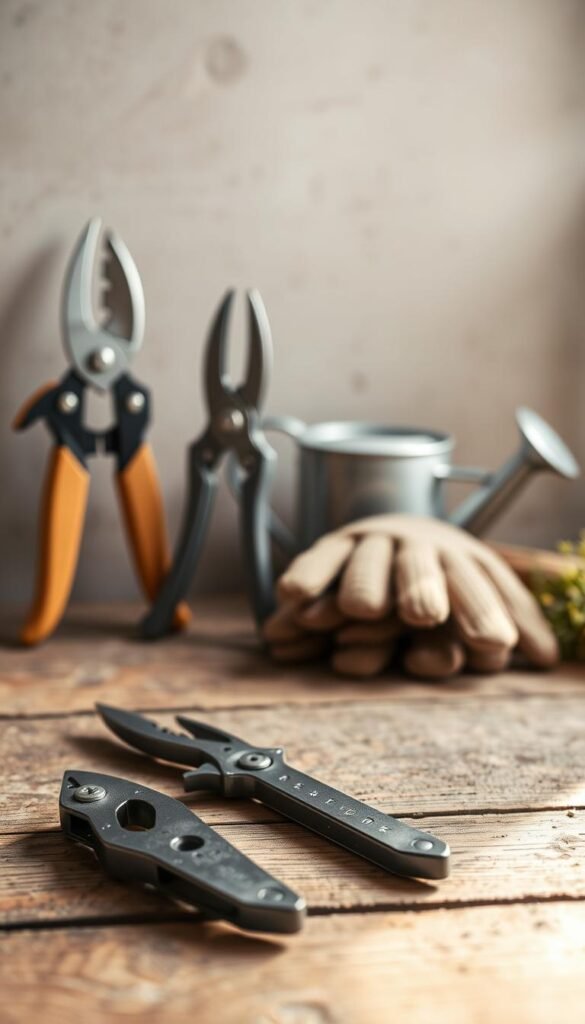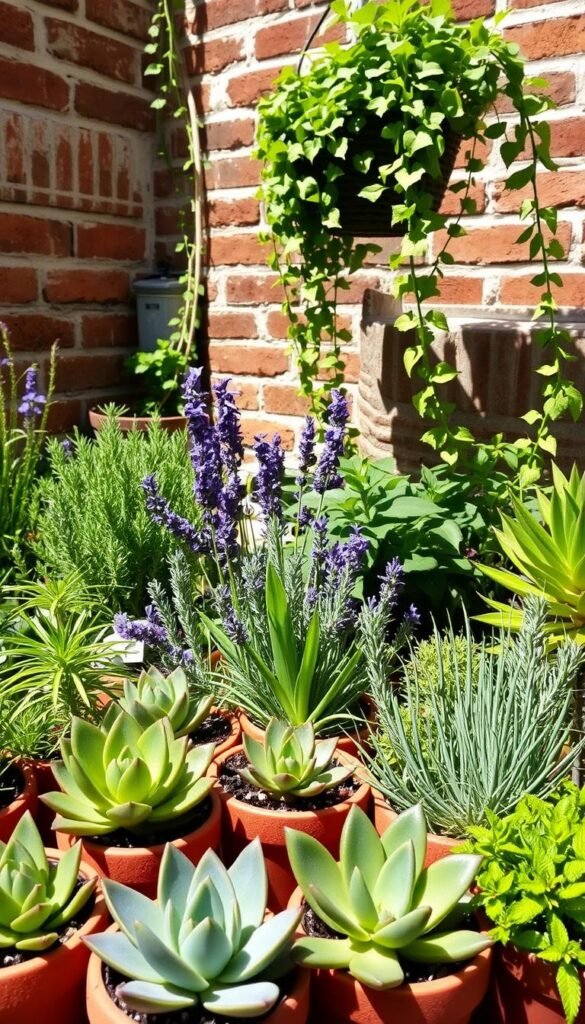Imagine stepping outside to a lush green space that thrives without demanding hours of your time. For urban dwellers juggling packed schedules, creating a vibrant garden isn’t just a dream—it’s entirely achievable. You don’t need a green thumb or endless weekends to cultivate a refreshing oasis in the heart of the city.
This guide focuses on resilient varieties that handle limited space, pollution, and irregular watering. Think drought-tolerant species like Japanese Stewartia or fast-growing evergreens such as Thuja Green Giant. These picks require minimal pruning and adapt well to urban microclimates.
We’ve curated this list using insights from trusted growers like Thuja Gardens and The Sill. Each plant balances beauty with practicality, ensuring your garden stays lively even when life gets hectic. Whether you’re tending a balcony or a tiny backyard, these options simplify your routine.
Best part? You’ll spend less time fussing over care and more time enjoying your leafy retreat. Let’s explore how to transform your space with greenery that works as hard as you do.
Introduction: Embracing Urban Gardening with Ease
Balancing work and life in the city? Your green space doesn’t have to become another chore. Urban gardening has surged in popularity as more people crave nature’s calm amid concrete landscapes. It’s about creating pockets of tranquility that fit seamlessly into fast-paced routines.
Limited space and challenging soil conditions often deter aspiring growers. Rooftop containers, balcony boxes, and tiny yards demand creative solutions. Compact spaces mean roots compete for nutrients, and pollution can stress delicate varieties. But here’s the secret: choosing resilient plants transforms these hurdles into opportunities.
Understanding your soil type and watering rhythm changes everything. Many urban setups have poor drainage or packed clay—common issues that hardy species handle with ease. Pair this knowledge with drought-tolerant picks, and you’ll spend weekends relaxing, not wrestling with maintenance.
This guide shares straightforward strategies to help your garden flourish. From selecting adaptable greenery to optimizing layouts, we focus on what works in real-world settings. You’ll discover how a few smart choices can yield big rewards—lush foliage without the fuss.
Remember, a thriving urban oasis isn’t about perfection. It’s about embracing plants that grow with you, not against your schedule. Ready to simplify your green journey?
Choosing the Right Low-Maintenance Plants for Your City Garden
What if your garden thrived even when you’re swamped? Start by picking varieties that match your schedule. Resilient options like lavender and hostas shine with minimal care—they bounce back from dry spells and bloom without constant pruning.
Focus on species with drought tolerance and sturdy leaves. Sedum, for example, stores water in its thick foliage, surviving weeks without attention. Hardy evergreens like boxwood keep their color year-round, cutting down on maintenance tasks.
Assess your space first. How much sunlight hits your balcony? Is your soil sandy or clay-heavy? Matching plants to these conditions slashes time spent troubleshooting. Compact varieties like dwarf hydrangeas fit tight corners while offering vibrant leaves.
Prioritize slow-growing species to reduce trimming. Ornamental grasses like fountain grass add texture without demanding frequent cuts. Their flowing blades sway in the breeze, creating movement that masks urban noise.
Remember: every minute saved on watering or pruning means more time to unwind. With smart picks, your green space becomes a self-sustaining retreat—not another chore on your list.
Discover 5 Low-Maintenance Plants for Busy City Gardeners
Your urban oasis deserves greenery that matches your pace—thriving without constant upkeep. Meet five resilient varieties chosen for their ability to flourish with minimal effort while adding vibrant textures to compact spaces.
These selections combine striking foliage with adaptability to urban challenges like pollution and erratic watering. From ornamental trees to flowering perennials, each brings unique character while asking little in return.
- Japanese Stewartia: Offers year-round interest with peeling bark and summer blooms. Its foliage transitions beautifully across seasons.
- Thuja Green Giant: A fast-growing evergreen that forms a lush privacy screen without frequent trimming.
- Sedum: Stores water in its fleshy leaves, thriving on neglect and blooming late into fall.
- Hostas: Shade-tolerant stars with striking leaf patterns that return stronger each spring.
- Fountain Grass: Adds graceful movement with arching blades that sway in breezy balconies.
What makes these picks ideal? They demand attention only during initial planting. Once established, occasional watering and seasonal cleanup keep them thriving. You’ll spend more time enjoying their textures than tending to them.
Upcoming sections break down specific care strategies tailored for hectic lifestyles. Learn how to pair these varieties for continuous visual interest while keeping maintenance light. Your green retreat awaits—effortless, adaptable, and always refreshing.
Top Low-Maintenance Trees and Shrubs for Urban Spaces

Want greenery that anchors your space without anchoring you down? Strategic selections among woody varieties bring structure and year-round appeal to concrete jungles. These types work smarter, not harder—growing steadily while filtering city air and softening harsh lines.
Architectural Beauty Meets Practicality
Japanese Stewartia stands out with peeling cinnamon bark that reveals creamy patches—nature’s artwork evolving through seasons. Its vase-shaped canopy offers dappled shade for patio seating areas. Once established, this stunner handles dry spells better than most ornamental trees.
Thuja Green Giant delivers rapid vertical growth, forming dense evergreen walls within 3-5 years. Perfect for screening noisy streets or neighboring windows, it naturally resists pests and diseases. You’ll love how its rich green foliage stays vibrant through winter’s grayest days.
Smart Growth, Less Work
Both selections share key advantages for time-crunched growers. Their drought tolerance means you can skip weekend watering during heat waves. Minimal pruning keeps maintenance simple—just remove dead branches in early spring if needed.
These types encourage new growth without constant attention. Thuja’s vertical habit requires no shaping, while Stewartia’s symmetrical form matures gracefully. You’ll notice fuller canopies each year, creating that established garden look faster than fussier varieties.
By choosing woody plants adapted to urban stresses, you invest in long-term beauty. They become resilient partners in your green journey, thriving through hectic weeks and seasonal shifts alike.
Adapting Soil and Garden Design for City Environments
Ever wonder why some urban gardens thrive while others struggle? The secret lies in tailoring your space to work with nature’s constraints rather than against them. Let’s explore how simple adjustments to soil and layout can transform your green corner.
Soil Secrets for Concrete Jungles
Start by testing your soil’s texture and pH. Many city plots have compacted clay or sandy mixes that drain poorly. Mix in compost to boost nutrients or perlite to improve drainage. For container gardens, use quality potting mix with slow-release fertilizer.
Track how light moves across your space. South-facing balconies get intense sun, while north-facing ones stay shady. Arrange plants accordingly—drought-tolerant varieties like sedum in bright spots, shade-loving hostas where light is scarce.
| Plant Type | Light Needs | Watering Frequency | Care Tip |
|---|---|---|---|
| Sedum | Full sun | Every 2-3 weeks | Use gritty soil mix |
| Hostas | Partial shade | Weekly | Mulch to retain moisture |
| Fountain Grass | 6+ hours sun | Biweekly | Trim dead blades in spring |
Group plants with similar watering needs together. This prevents overwatering some while underwatering others. Self-watering planters or drip irrigation systems save time for busy schedules.
Design Smart, Work Less
Maximize vertical space with wall planters or trellises. Tiered plant stands create depth in narrow areas while improving air circulation. Choose lightweight containers with drainage holes to prevent root rot.
Remember: successful urban gardens embrace flexibility. Swap out seasonal plants easily by using modular containers. Add mulch to reduce evaporation and suppress weeds—two tasks crossed off your care checklist!
By aligning your design with local conditions, you create a resilient ecosystem that practically tends itself. Less adjusting, more enjoying—that’s the urban gardener’s sweet spot.
Essential Gardening Tips for the Busy Urban Gardener

Transform your urban garden into a low-effort sanctuary with these expert-backed strategies. Smart routines help plants thrive while respecting your packed schedule—no green thumb required.
First, master sunlight management. Track how shadows move across your space using free apps like Sun Seeker. Rotate pots weekly so all sides get equal exposure. For south-facing areas, use sheer curtains to filter intense afternoon rays.
Boost growth with these hacks:
- Water deeply but less often—this encourages stronger roots
- Add coffee grounds to soil for slow-release nitrogen
- Use clear pebble mulch to reflect light onto lower leaves
| Plant Type | Light Needs | Growth Hack |
|---|---|---|
| Succulents | 6+ hours direct | Rotate pots monthly |
| Ferns | Filtered shade | Mist leaves weekly |
| Herbs | 4-6 hours sun | Harvest outer leaves first |
Adapt to changing conditions with simple checks. Press your finger into soil—if it’s dry two inches down, water thoroughly. Notice leggy stems? Move plants closer to light sources. The Sill recommends monthly “plant check-ins” to catch issues early.
Remember: consistency beats perfection. Set phone reminders for key tasks like fertilizing or seasonal pruning. Your garden will reward you with steady growth, even when life gets chaotic.
Effortless Greenery: How Succulents Enhance Your Garden
Craving greenery that thrives on autopilot? Succulents are nature’s multitaskers—storing water in their plump leaves and thriving where other plants falter. Their sculptural forms add modern flair to windowsills, fire escapes, and coffee tables, making them ideal for time-strapped urbanites.
Light, Water, and Layout Requirements
These hardy plants prefer bright, indirect light—think east-facing windows or shaded patios. As The Sill notes, varieties like Sedum adapt to low-light corners but grow more vibrant with 4-6 hours of filtered sun. Overwatering is their #1 enemy: wait until soil feels bone-dry before giving a thorough soak.
| Type | Light Needs | Watering | Leaf Feature |
|---|---|---|---|
| Echeveria | Bright indirect | Every 3 weeks | Rosette shape |
| Haworthia | Low to moderate | Monthly | Striped texture |
| Sedum | Full sun to partial shade | Biweekly | Fleshy clusters |
Arrange succulents in shallow containers with gritty soil for quick drainage. Mix tall varieties like Snake Plant with trailing types like String of Pearls for dynamic displays. Their varied leaf textures—from spiky aloes to smooth jade plants—create visual depth without crowding small spaces.
Best part? These slow growers need repotting only every 2-3 years. A quick wipe of dusty leaves keeps them photosynthesizing efficiently. With minimal effort, your succulent collection becomes a self-sustaining slice of greenery that outlasts even your busiest weeks.
Ornamental Grasses and Flowering Plants for a Colorful Touch

Who says small spaces can’t burst with color? Ornamental grasses and flowering perennials bring life to urban gardens with minimal effort. Their natural textures and hues create dynamic displays that shift with the seasons—even when temperatures drop.
Low-Maintenance Perennials to Brighten Your Space
Daylilies and Black-Eyed Susans top the list of hardy varieties that thrive on neglect. These bloomers return yearly with brighter foliage, needing only basic sunlight and occasional watering. Their deep roots help them survive dry spells, making them ideal for forgetful gardeners.
Consider these benefits when selecting plants:
- Winter interest: Feather reed grass retains golden plumes through frost
- Natural pest resistance: Coneflowers deter deer while attracting pollinators
- Color variety: Russian sage offers lavender blooms against silvery leaves
| Plant | Seasonal Feature | Care Tip |
|---|---|---|
| Switchgrass | Fall red foliage | Cut back in early spring |
| Sedum ‘Autumn Joy’ | Winter seed heads | Avoid rich soils |
| Coreopsis | Summer-long blooms | Deadhead monthly |
For winter appeal, try evergreen grasses like blue fescue. Their steel-blue blades add contrast to snowy landscapes. Come spring, a quick trim removes dead growth—no complicated pruning needed.
Pair these varieties with gravel mulch to reduce watering. You’ll enjoy a lively garden that adapts to your schedule, proving even compact spaces can radiate natural beauty year-round.
Indoor Low-Maintenance Plant Options for Compact City Living
Your apartment can bloom with life even when your schedule doesn’t. Indoor greenery thrives in small spaces, offering clean air and calming vibes without demanding constant care. The key? Choosing species that adapt to your home’s light and humidity while fitting seamlessly into your routine.
Pet-Safe Varieties and Easy-Care Foliage Plants
For homes with curious cats or dogs, safety comes first. The Money Tree (Pachira aquatica) tops Rooted’s recommended list—its braided trunk adds style, and it’s non-toxic if nibbled. Pair it with a Bird’s Nest Fern, whose ripple-edged leaves purify air and tolerate low-light corners.
ZZ Plants shine for forgetful gardeners. Their waxy leaves store water for weeks, surviving irregular watering. Just keep them away from direct sunlight—bright indirect light keeps their glossy foliage vibrant.
| Plant | Light Needs | Watering | Pet-Safe? |
|---|---|---|---|
| Spider Plant | Bright indirect | Every 10 days | Yes |
| Parlor Palm | Low light | Biweekly | Yes |
| Snake Plant | Any light | Monthly | No |
In spring, increase watering slightly as daylight hours grow. Most indoor varieties need only 2-3 hours of attention weekly—wipe leaves, check soil moisture, and rotate pots for even growth. The Sill suggests using self-watering pots to stretch time between refills.
Compact picks like Peperomia thrive on shelves or desks, their succulent-like leaves adding texture without bulk. With smart choices, you’ll create a green haven that fits both your space and schedule.
Minimal Pruning and Maintenance Techniques That Work

Keeping your green space vibrant doesn’t have to mean endless chores. Smart pruning methods and quality tools let your tree and shrub additions grow strong while saving you hours. Focus on strategic cuts that enhance natural shapes rather than constant trimming.
Selecting the Right Tools for Effortless Care
Start with three essentials: bypass pruners for clean cuts, a folding saw for thicker branches, and telescopic loppers for hard-to-reach spots. These tools reduce strain and prevent damage to plant tissue. Quality matters—stainless steel blades stay sharp longer, requiring fewer replacements.
| Tool | Purpose | Frequency of Use |
|---|---|---|
| Bypass Pruners | Precision cuts on small branches | Monthly |
| Folding Saw | Removing deadwood up to 4″ thick | Twice yearly |
| Telescopic Loppers | Shaping tall shrubs | Seasonally |
Time your pruning right. Late winter works best for most tree additions, letting wounds heal before pests emerge. For flowering shrubs, wait until after blooms fade. This approach maintains plant health without disrupting your routine.
Remember: you need to remove only dead or crossing branches. Over-pruning stresses plants and increases maintenance. A 20-minute monthly check preserves structure while letting greenery thrive naturally.
Pair these techniques with drought-tolerant additions that need less attention. Your garden becomes a self-regulating ecosystem—less work for you, more resilience over time.
Managing Watering and Sunlight in a Busy Urban Setting
Juggling work and city life leaves little time for garden upkeep, but smart strategies keep your plants thriving. Urban spaces often face erratic light patterns and dry air, requiring tailored approaches. The solution? Sync your plant care with your routine using tech and simple adjustments.
Smart Irrigation and Light Scheduling Tips
Start by grouping plants with similar schedules. Drought-tolerant varieties like snake plants can go weeks without water, while ferns need consistent moisture. Pairing them in separate zones prevents over- or under-watering.
Use indirect light to your advantage. Place light-sensitive plants near north-facing windows or behind sheer curtains. Reflective surfaces like white planters bounce sunlight to lower leaves, maximizing exposure without scorching.
| Irrigation Method | Best For | Frequency | Setup Time |
|---|---|---|---|
| Self-Watering Planters | Small spaces | 2-4 weeks | 5 minutes |
| Drip Systems | Balcony gardens | Customizable | 30 minutes |
| Smart Timers | Larger setups | App-controlled | 1 hour |
Adjust care with the seasons. Reduce watering in winter when growth slows. Rotate pots monthly to ensure even indirect light distribution as sun angles shift.
Automation tools simplify routines:
- Wi-Fi-enabled sensors track soil moisture
- Programmable grow lights supplement cloudy days
- Calendar alerts remind you to check plant variety needs
Experts at Bloomscape recommend testing one tool at a time. Start with a basic self-watering pot for your thirstiest variety, then expand as you see results. Your greenery stays lush, even when your schedule isn’t.
Seasonal Care: Keeping Your Garden Healthy All Year

Your garden’s needs shift as seasons turn—but adapting doesn’t mean starting over. Resilient varieties handle temperature swings and light changes with simple tweaks to your routine. Focus on what matters: protecting roots, optimizing moisture, and encouraging steady growth.
Winter Wisdom and Spring Renewal
When frost arrives, mulch becomes your best friend. Spread 2-3 inches around low-maintenance plants to insulate roots. For potted greenery, wrap containers in burlap or move them against walls to block icy winds. Check soil dryness monthly—water only if the top inch feels crumbly.
Spring brings growth spurts. Feed plants with slow-release fertilizer as buds emerge. Prune dead branches early to direct energy to healthy stems. If you notice leggy growth in low light areas, rotate pots weekly for even sun exposure.
| Season | Key Task | Tool Tip |
|---|---|---|
| Winter | Mulch application | Use shredded bark |
| Spring | Balanced fertilizing | 10-10-10 NPK ratio |
| Drought | Deep watering | Soaker hoses |
Thriving Through Dry Spells
Heat waves demand smart hydration. Water deeply at dawn to reduce evaporation. Group low-maintenance plants by thirst levels—sedum and lavender can handle soil dryness, while ferns need shaded, damp corners. Add pebble trays under pots to boost humidity naturally.
In prolonged droughts, prioritize young trees and shrubs. Their developing roots rely on consistent moisture. For established greenery, stretch watering intervals to encourage deeper root growth. Your garden will reward you with lush resilience.
Expert Advice and Community Insights for Urban Gardeners
Ever feel like your urban garden could use a mentor? Seasoned plant specialists and fellow growers share battle-tested strategies to simplify your journey. Paris Lalicata, a horticulturist at The Sill, notes: “Success starts with matching plants to your lifestyle—like the snake plant, which thrives on neglect while purifying air.”
Proven Strategies From the Trenches
Communities like Rooted emphasize smart garden design for cramped spaces. One Brooklyn gardener transformed her fire escape using vertical planters filled with drought-tolerant picks. Her secret? “Group plants by light needs and use self-watering pots during busy weeks.”
Key lessons from experts:
- Start with 2-3 easy grow varieties like ZZ plants or pothos
- Use modular containers to adapt layouts as needs change
- Join local Facebook groups for microclimate-specific tips
| Expert-Recommended Plant | Key Benefit | Care Hack |
|---|---|---|
| Snake Plant | Air purification | Water every 4-6 weeks |
| Spider Plant | Pet-safe | Mist weekly |
| Peperomia | Compact size | Rotate monthly |
Adjust these ideas to your space. North-facing window? Try low-maintenance picks like cast iron plants. Limited floor area? Wall-mounted herb gardens maximize vertical real estate. As Lalicata advises: “Your garden design should solve problems, not create them.”
Real success stories show what’s possible. A Chicago couple grows 15 easy grow species in 300 sq ft—using timers and thrifted containers. Their mantra? “Work with your environment, not against it.” Your turn to blend expert wisdom with personal flair.
Creating Your Personal Green Retreat with Minimal Effort
Your balcony or windowsill holds untapped potential—a blank canvas waiting to become your private sanctuary. With top low-maintenance selections, you can craft a calming oasis that thrives with little effort. It’s about blending form and function to create a space where you recharge, not labor.
Start by choosing plants that demand minimal attention. Snake plants and ZZ varieties purify air while surviving irregular watering. Pair them with trailing pothos to add vertical interest without complex care routines. These resilient picks form the backbone of your retreat, staying lush through hectic weeks.
| Plant | Texture/Color | Care Level |
|---|---|---|
| Snake Plant | Vertical stripes | Water monthly |
| ZZ Plant | Glossy leaves | Low light tolerant |
| Sedum | Fleshy clusters | Drought-resistant |
Layer textures for visual depth. Combine spiky dracaena with soft ferns in corner planters. Add pops of color using flowering kalanchoe—their bright blooms last weeks with little effort. Use mirrored accents to amplify greenery in tight spaces, creating an illusion of abundance.
Maximize comfort with foldable seating nestled among planters. Hang string lights above your top low-maintenance arrangements for evening ambiance. A small water feature with floating succulents adds soothing sounds without maintenance hassles.
Personalize your retreat by displaying plants in thrifted containers or hand-painted pots. This blend of practicality and creativity turns cramped areas into cherished escapes. Your urban jungle awaits—where minimal attention meets maximum serenity.
Integrating Low-Maintenance Plants into Your Daily Routine
Discover how effortless plant care can become a natural part of your day. With smart planning, your green space thrives while fitting into your existing schedule—no extra hours required.
Step-by-Step Strategies for a Stress-Free Garden
Start by mapping sunlight patterns. Identify areas with partial shade where ferns or hostas flourish with minimal watering. These spots naturally retain moisture, cutting your water needs by up to 30%.
| Time Slot | Action | Tool |
|---|---|---|
| Morning coffee | Check soil moisture | Finger test |
| Lunch break | Rotate pots | Smartphone light meter |
| Evening wind-down | Deep watering | Self-watering spike |
Group thirsty plants near your kitchen sink for quick refills. Use drip trays under containers in partial shade to prevent overflows. This setup lets you multitask—water while prepping meals or waiting for coffee.
Sync care tasks with existing habits. Set phone reminders to inspect leaves every 10 days. Apps like Planta track growth and water schedules, sending alerts when action’s needed. You’ll catch issues early without memorizing routines.
A low-maintenance garden isn’t just easier—it’s therapeutic. Studies show brief daily interactions with plants lower stress hormones. Your green corner becomes a calming ritual, not a chore list.
Upgrade tools for efficiency:
- Use moisture meters to avoid guesswork
- Install timers on irrigation systems
- Choose ceramic pots that regulate soil temperature
With these tweaks, your low-maintenance garden seamlessly blends into city life. You’ll nurture growth while reclaiming time for what matters most.
Final Reflections and Encouragement for Your Low-Maintenance Garden
Even the busiest schedules can nurture a vibrant green retreat. By choosing resilient varieties that match your space and lifestyle, you create a self-sustaining ecosystem. Thoughtful selections like drought-tolerant flowers or compact shrubs ensure beauty without constant upkeep.
Remember: small efforts yield big rewards. A weekly watering session or seasonal pruning keeps your flowers blooming through summer heat. Your balcony or windowsill transforms into a living canvas, where textures and colors shift with the light.
Urban gardening thrives on simplicity. Those five minutes spent rotating pots or checking soil moisture? They add up to lush flowers that outshine concrete views. Every tiny action strengthens your connection to nature’s rhythms.
Your space isn’t just surviving—it’s flourishing. Trust the process, celebrate each new leaf, and let your green haven grow alongside you. The proof? Those cheerful blossoms greeting you after a hectic week, whispering: “You’ve got this.”





